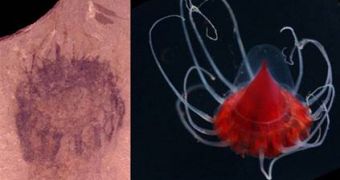Imagine you find your grandma's jelly fossilized hundreds of millions of years later? Such an unusual find took place in Utah: the oldest till now discovered fossil of a jellyfish, over 500 million years old. Such soft-bodied animals rarely leave behind fossils, unlike animals with hard shells or skeletons (bones or crusts). "The fossil record is biased against soft-bodied life forms such as jellyfish, because they leave little behind when they die," said co-author Bruce Lieberman of the University of Kansas.
This exceptional fossil has been preserved because the animal was deposited in fine sediment, not in coarse sand, in a film that revealing an accurate image ("fossil snapshot") of the ancient jellyfish. "You can see a distinct bell-shape, tentacles, muscle scars and possibly even the gonads," said co-author Paulyn Cartwright, also a researcher of the University of Kansas.
This detailed inner organization allowed the researchers to compare it with the living cnidarians, the primitive animal phylum comprising jellyfish, coral and sea anemones. This investigation clearly showed that the fossils were of a jellyfish and set the age of the ancient jellyfish at about 505 million years old, which makes it the oldest known jellyfish. The previously discovered fossilized jellyfish was dated to 300 million years ago. "The fossils also offer insights into the rapid species diversification that occurred during the Cambrian radiation, which began around 540 million years ago, when most animal groups start to show up in the fossil record," Lieberman said.
Scientists were surprised to find in this basic jellyfish the complexity of modern jellyfish, suggesting that 500 million years ago, jellyfish either experienced a rapid evolution or they were in fact even much older and by that time, they had been developing for quite a long time.

 14 DAY TRIAL //
14 DAY TRIAL //